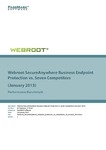Micro-windmills can recharge cell phones
- 15 January, 2014 22:53
- Comments
Researchers at the University of Texas at Arlington have designed a miniscule windmill with a micro-generator that can be used to recharge mobile devices.
Smitha Rao, a university research associate, and J.-C. Chiao, an electrical engineering professor, designed the micro-windmills. The two have filed for a patent for the devices, which are about 1.8 mm at their widest point.
A single grain of rice could hold about 10 of the tiny devices, and the researchers believe hundreds of them could be embedded in a cell phone sleeve for recharging purposes. Once the sleeve is on the phone, a user would simply wave the device in the air or set the phone in a windy place to get the tiny propeller blades turning, allowing the micro-generators to produce electricity.
The windmills compared to a penny. The wind generators are bout 1.8 mm at their widest point.
The researchers' work attracted the attention of Taiwanese electro-mechanical fabrication company WinMEMSTechnologies, which has the researchers brainstorming on designs.
"The company was quite surprised with the micro-windmill idea when we showed the demo video of working devices," Rao said in a statement. "It was something completely out of the blue for them and their investors."
The idea for the windmills was originally a blend of origami concepts and conventional wafer-scale semiconductor device layouts created so the complex 3-D moveable mechanical structures can be self-assembled from two-dimensional metal pieces using planar multilayer electroplating techniques.
"The micro-windmills work well because the metal alloy is flexible and Smitha's design follows minimalism for functionality," Chiao said in a statement.
Once WinMEMS became interested in the research, it started a relationship with UT-Arlington. Company representatives visited with the UT-Arlington team several times last year to discuss collaboration. An agreement between the school and WinMEMS allows UT-Arlington to hold the intellectual property rights to the micro-windmills while WinMEMS explores commercial opportunities.
WinMEMS Technology demonstrates the micro-windmills.
The micro-windmills include gears, inductors, pop-up switches and grippers. All of those parts are as tiny as a fraction of the diameter of a human hair.
"It's very gratifying to first be noticed by an international company and second to work on something like this where you can see immediately how it might be used," said Rao. "However, I think we've only scratched the surface on how these micro-windmills might be used."
The micro-windmills were tested successfully in September 2013 in Chiao's lab. The windmills operate under strong artificial winds without any fracture in the material because of the durable nickel alloy and the aerodynamic design.
"The problem most MEMS designers have is that materials are too brittle," Rao said. "With the nickel alloy, we don't have that same issue. They're very, very durable."
The micro-windmills can be made in an array using batch processes. The fabrication cost of making one device is the same as making hundreds or thousands on a single wafer, which enables for mass production of very inexpensive systems.
"Imagine that they can be cheaply made on the surfaces of portable electronics," Chiao said, "so you can place them on a sleeve for your smart phone. When the phone is out of battery power, all you need to do is to put on the sleeve, wave the phone in the air for a few minutes and you can use the phone again."
Chiao said because of the small sizes, flat panels with thousands of windmills could be made and mounted on the walls of houses or building to harvest energy for lighting, security or environmental sensing and wireless communication.
Lucas Mearian covers consumer data storage, consumerization of IT, mobile device management, renewable energy, telematics/car tech and entertainment tech for Computerworld. Follow Lucas on Twitter at @lucasmearian or subscribe to Lucas's RSS feed. His e-mail address is lmearian@computerworld.com.
See more by Lucas Mearian on Computerworld.com.
Read more about emerging technologies in Computerworld's Emerging Technologies Topic Center.
- Bookmark this page
- Share this article
- Got more on this story? Email TechWorld
- Follow TechWorld on twitter
-
Why Facebook and Google+ are headed in opposite directions
-
Bio-printing human parts will spark ethical, regulatory debate
-
Westpac Australia apologises for online banking issues
-
Treasury takes on startup employee share options
-
Six more US retailers hit by Target-like hacks, security firm says


.jpg)















Recent comments
2 days, 16 hours ago
5 days, 1 hour ago
5 days, 7 hours ago
1 week, 5 days ago
2 weeks, 2 days ago
2 weeks, 3 days ago
2 weeks, 4 days ago
2 weeks, 4 days ago
3 weeks, 1 day ago
3 weeks, 2 days ago